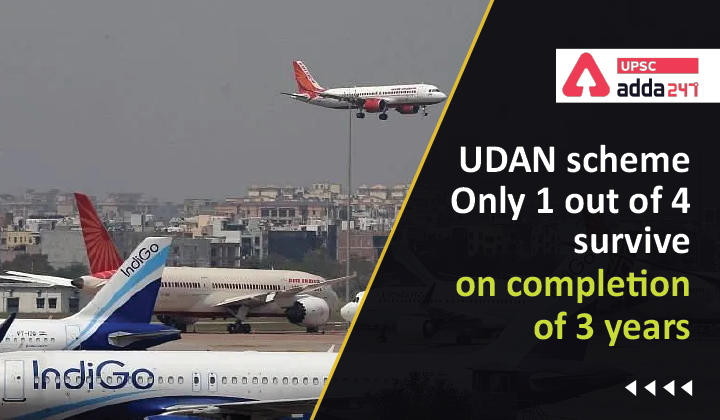Table of Contents
UDAN scheme: Relevance
- GS 2: Government policies and interventions for development in various sectors and issues arising out of their design and implementation.
UDAN scheme: Context
- Recently, Ministry of Civil Aviation has informed the parliamentary panel that only one out of four routes under the UDAN (Ude Desh ka Aam Nagrik) scheme have survived after completing the government’s subsidy period of three years.
Only 1 out of 4 survive on completion of 3 years: Key points
- Of the 94 RCS (Regional Connectivity Scheme)-UDAN routes that have completed 3-year tenure till Nov 2021, only 22 routes are in operation.
- UDAN scheme is aimed to take flying to the masses and improve air connectivity to tier-2 and tier-3 cities.
- Under the scheme, airlines have to cap fares at ₹2,500 per seat per hour of flight for 50% of the seats in a plane for which they receive a viability gap funding (subsidy) from the government along with some other benefits.
- The government expected that after the expiry of the three-year subsidy period, airlines would be able to sustain the routes without outside support.
Only 1 out of 4 survive on completion of 3 years: Reasons
- Pluming of demand: 300 routes have been affected due to poor demand on account of Covid-19 pandemic situation.
- Difficult business: Airline is a difficult business due to low yield and high operating costs, which often makes the airline business untenable.
- Lack of slots at congested airports like Delhi and Mumbai.
- Non-availability of smaller planes and maintenance issues which require procurement of spare parts from abroad.
- Delay in airport completion: Delays in completing airport development work due to lack of funds and non-availability of land.
UDAN scheme: Key points
About UDAN
- UDAN scheme full form: Ude Desh Ka Aam Naagrik is a Regional Connectivity Scheme (RCS) to ensure affordability, connectivity, growth and development.
- It provides a win-win situation for all stakeholders – citizens would get the benefit of affordability, connectivity and more jobs.
- The scheme was launched in 2016 and would be in operation for a period of 10 years.
UDAN scheme benefits
- Central Government would provide concessions in the form of reduced excise duty, service tax, and flexibility of code sharing at the RCS (UDAN) airports.
- State governments will have to lower the GST on ATF to 1% or less, besides providing security and fire services free of cost and electricity, water and other utilities at substantially concessional rates.
- A Regional Connectivity Fund would be created to meet the viability gap funding requirements under the scheme. The RCF levy per departure will be applied to certain domestic flights.
- The partner State Governments (other than Northeastern States and Union Territories where contribution will be 10 %) would contribute a 20% share to this fund.
Also Read:





 TSPSC Group 1 Question Paper 2024, Downl...
TSPSC Group 1 Question Paper 2024, Downl...
 TSPSC Group 1 Answer key 2024 Out, Downl...
TSPSC Group 1 Answer key 2024 Out, Downl...
 UPSC Prelims 2024 Question Paper, Downlo...
UPSC Prelims 2024 Question Paper, Downlo...




